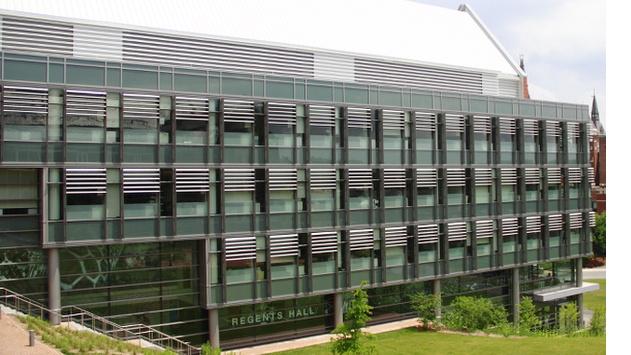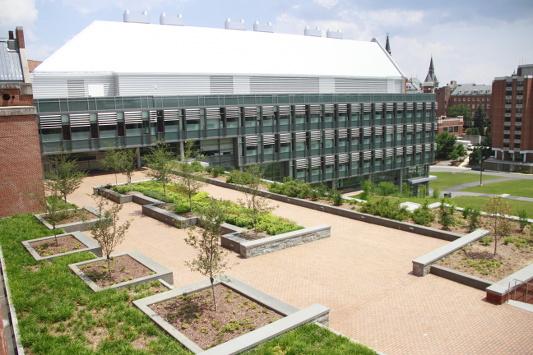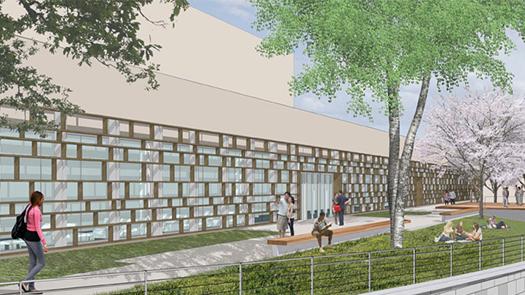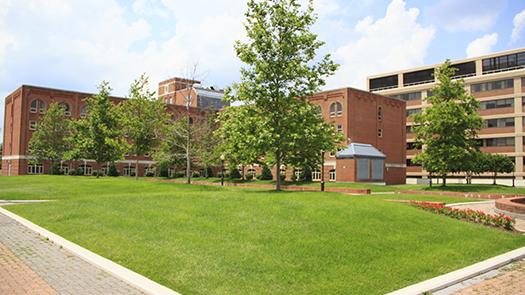Stormwater Management

Background
Georgetown is helping improve local watershed health by taking steps to reduce runoff.
Stormwater is excess rainfall not absorbed into the ground, that runs along hard surfaces and into storm drains until reaching a body of water or treatment facility. Stormwater can pick up and carry pollutants such as lawn chemicals and oil from cars into our natural waterways, and can produce soil erosion, which has detrimental impacts on existing infrastructure and watershed health.
Georgetown’s location on the hilltop and demands careful stormwater management, as excessive water can carry pollutants into the Potomac River. High runoff volumes can also stress our city’s historic infrastructure, as ongoing urban development in the region creates more impermeable surfaces, increasing runoff and exceeding existing capacity of the city’s built systems.
Solutions
By slowing down or capturing stormwater on campus rather than allowing it to run off, Georgetown is helping decrease water pollution and increase watershed health in our local region. Careful stormwater management can provide synergistic sustainability benefits, such as increasing habitat for native species, providing green space for contemplation and recreation, and displacing potable water consumption.
Green Roofs
In addition to reducing and delaying stormwater runoff, green roofs act as insulators by reducing heat and cooling loss, reduce urban heat island effect by humidifying and cooling the surrounding air, filter airborne dust and other particles, reduce CO2 levels, insulate buildings, absorb sound and increase the habitat for birds and butterflies.
Georgetown’s campus has at least three significant green roofs, including the Leavey Esplanade, the Southwest Quadrangle (which decks over a parking garage with a grassy courtyard) and the green area adjacent to Regents Hall. The gravel, soil and sand deposits underneath the plants help filter pollutants from the absorbed stormwater.
Cisterns and Rain Barrels
Cisterns and rain barrels, though differing greatly in size, serve similar functions: collecting rainwater, and storing it for future use. At Georgetown, a 20,000 gallon cistern harvests rainwater from the roof and site of Regents Hall science building, using it for toilet flushing and irrigation on site. This system not only reduces stormwater runnoff, but also reduces potable water demand in the building.
In Nevils courtyard, a 170 gallon Aqualok “Bioswale” unit collects rainwater via a downspout from a portion of the Nevils rooftop, slowly infiltrating into the nearby soil to deter water from the storm sewer and instead use it to water a nearby tree.
Rain Gardens
A rain garden is typically a shallow depression in the landscape planted with deep-rooted native plants and grasses. They help infiltrate stormwater, remove pollutants from runoff, and provide habitat for native species. Georgetown’s Healey Student Center is being designed to channel runoff from the site into a new raingarden that will decrease runoff while increasing green space on campus.
More Resources
Explore the sites below to learn more about stormwater and how you can help!

Regents Hall is designed to collect up to 20,000 gallons of rainwater for reuse as greywater in the building and for irrigation.

A green roof atop lab space, classrooms and study areas in Regents Hall provides habitat for natives species and reduces runoff.

The Healey Student Center site is designed to capture rainwater and channel the runoff into a rain garden of native and adaptive plants.

The Leavey Esplanade’s intensive green roof contains trees, shrubs and space for activities. The green roof provides insulation and stormwater management for the building and site.